China and Iran are two states that will cross many students’ paths as they progress in their studies Both nations – for very different reasons – are at the centre of important contemporary debates in international relations, such as hegemony, nuclear proliferation, security and economics.
Consequently, there is a lively monograph output in academia bringing cutting-edge perspectives to the roles of both states. The books featured here are excellent reading for students who are specialising in either state in dissertation research, or on advanced modules. While monographs can be expensive for personal purchase, they are often excellent investments. In addition, it is always possible that your library will have a copy, and if not you can always request that they add a title to their collection.
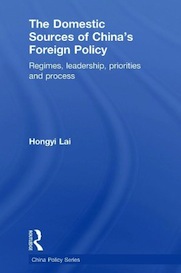 The Domestic Sources of China’s Foreign Policy by Hongyi Lai takes the reader through a very refreshing analysis of China’s foreign policymaking. Lai’s central mission is to assert that the mainstream literature, particularly neo-realist output, inaccurately treats Chinese policymaking in international relations as predominantly shaped by external events. Instead, policy making is dominated by the very domestic concerns of the preservation of the regime.
The Domestic Sources of China’s Foreign Policy by Hongyi Lai takes the reader through a very refreshing analysis of China’s foreign policymaking. Lai’s central mission is to assert that the mainstream literature, particularly neo-realist output, inaccurately treats Chinese policymaking in international relations as predominantly shaped by external events. Instead, policy making is dominated by the very domestic concerns of the preservation of the regime.
The first part of the book takes the reader through the various debates, establishing the focus of the research (domestic issues) by contextualising and progressively eliminating other areas of focus. This section is an excellent scene-setter for the rest of the book and also forms a literature review of sorts – of high utility for any student.
The second part of the book is a set of self-contained chapters, each dealing with a specific focus – each of which can be read as stand-alone chapters if desired. The various chapters of the second section serve as a bit-by-bit assembly of the various domestic forces that drive China’s decision making – such as the regime’s leadership/succession debates; the domestic drivers of negotiations with the World Trade Organization; and issues of strategic resources from the perspective of the domestic economy and domestic growth. The stand-out chapter of the second section is an insightful analysis of the various institutions and players in China, and the truly diversified policy-making process. This may strike some readers as a contradiction, even a surprise, owing to China’s hierarchical political system. Here, Lai’s analysis is refreshing, and informed not just by his research expertise, but also from a personal perspective, having grown up in the late Mao era in China before leaving the country for graduate study.
The final section of the book, ‘Understanding a Rising China’, is a little too short and misses an opportunity to add to a weighty analysis to what is a raging contemporary debate. Yet, the strengths of the prior two sections secure the book as a worthwhile investment.
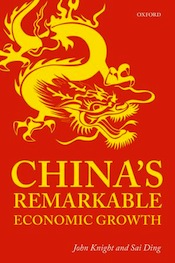 China’s Remarkable Economic Growth by John Knight and Sai Ding is another book heavily focused on domestic policies in China – making it an excellent compliment to Hongyi Lai’s text. However, it will appeal most to those looking for a purely economic analysis. Dealing first with the obligatory run-through of Chinese economic history and a serving of the various established approaches to understanding economic growth, readers will find themselves generally well equipped for the later chapters. Though, the quite dense economic focus of the book might require supplementary reading if a background in economic theory or international political economy is missing.
China’s Remarkable Economic Growth by John Knight and Sai Ding is another book heavily focused on domestic policies in China – making it an excellent compliment to Hongyi Lai’s text. However, it will appeal most to those looking for a purely economic analysis. Dealing first with the obligatory run-through of Chinese economic history and a serving of the various established approaches to understanding economic growth, readers will find themselves generally well equipped for the later chapters. Though, the quite dense economic focus of the book might require supplementary reading if a background in economic theory or international political economy is missing.
The book contains two major substantive sections – which look first at the determinants and then the consequences of China’s economic growth. These two sections are best read together rather than in isolation due to the authors’ ability – present through both sections – to integrate key questions and simultaneously offer answers though the use of various economic theories, empirical estimation and institutional analysis. Of particular note are the chapters on economic growth and inequality, and the effect of growth on the happiness of the Chinese workforce. In the latter case, the research on the relationship between income and happiness is well covered in the literature regarding developed nations. However, there is a dearth of literature focused on the developing world – or on China specifically. The authors here draw on the few available studies and deliver an analysis that covers rural, urban and migrant workers. The result – aided by helpful graphs and tables – is a very satisfying account of the shift in China in recent years from a national policy of merely raising wealth to one of also raising national happiness as it became apparent that happiness was fairly stagnant, perhaps falling, in the rapidly developing nation.
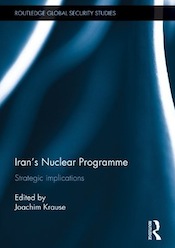 Iran’s Nuclear Programme, edited by Joachim Krause, examines the strategic implications of the ever-contentious Iranian quest to harness nuclear power. As might be expected from an edited volume, the various chapters are stand-alone, and written by different authors. While in some edited volumes this can be a weakness, the diversity of authorship/approach here is the notable strength of this volume. For any student or researcher into Iran’s nuclear programme, this book is a highly useful, frequently insightful, and ultra-contemporary volume that is a must-read.
Iran’s Nuclear Programme, edited by Joachim Krause, examines the strategic implications of the ever-contentious Iranian quest to harness nuclear power. As might be expected from an edited volume, the various chapters are stand-alone, and written by different authors. While in some edited volumes this can be a weakness, the diversity of authorship/approach here is the notable strength of this volume. For any student or researcher into Iran’s nuclear programme, this book is a highly useful, frequently insightful, and ultra-contemporary volume that is a must-read.
While a couple of the chapters cover familiar/predictable (yet essential) ground – such as the thorny issue of negotiating with Iran, or the evolving American approach towards Iranian proliferation – each is served up well and with the benefit of fresh insight. The most valuable chapters of the book are those that deal with domestic issues within Iran. Of particular note are two chapters on the effects of sanctions and their implications on Iranian society and Iran’s energy sector. Much as the two books on China featured above, the domestic focus here is a refreshing perspective that is often overlooked in the western literature.
Similarly, Shahram Chubin’s chapter on the domestic politics of the nuclear question in Iran adds a short, yet gainful contribution to the volume – adding further to the scope of the domestic element of the book. Also of note is Karl-Heinz Kamp’s chapter on the prospect of having to live with a nuclear-armed Iran. After running through various options/outcomes, Kamp concludes that the situation would not be grave – even if deterrence and diplomacy fail – if NATO developed a regional missile defence system to act as the ultimate insurance. Kamp’s chapter, twinned with Richard L. Russell’s examination of the preventive military options available for interrupting Iran’s nuclear development form an excellent component of the volume – and offer a refreshingly diverse range of viewpoints.
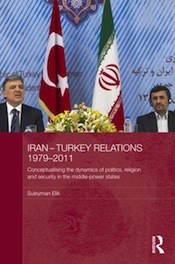 Iran-Turkey Relations 1979-2011 by Suleyman Elik does exactly what its title promises, and more. Considering the spreading of the Arab spring into Syria, Elik’s analysis – which encompasses regional politics and religious issues – is highly topical and very timely. Elik weaves a highly readable account of more than thirty years of diplomatic, security and energy relations – and in doing so establishes the central importance of both nations and their relations with each other to the wider regional political landscape.
Iran-Turkey Relations 1979-2011 by Suleyman Elik does exactly what its title promises, and more. Considering the spreading of the Arab spring into Syria, Elik’s analysis – which encompasses regional politics and religious issues – is highly topical and very timely. Elik weaves a highly readable account of more than thirty years of diplomatic, security and energy relations – and in doing so establishes the central importance of both nations and their relations with each other to the wider regional political landscape.
While there is much here for the diplomatic history enthusiast there is also a strong theoretical underpinning to the text via the use of middle-power relations theory. More specifically, a bespoke sub-type developed by the author for this case study: a middle-power states framework. Out of all the books featured here, this is the title most at home in the international relations theory camp, and readers should expect a heavy dose of theoretical analysis. As such, IR students and researchers will find much of interest of here as the case study is presented not just for its own sake – but also as an exploration and application of the aforementioned theoretical model, which is carefully integrated throughout the volume, forming its analytical focal point.
The utility of this book for many in the IR camp will ultimately fall on how well the particular reader feels that the theory used has been developed and defended. And, whether the reader agrees with Elik that the approach taken has been successful in contextualising and explaining the relationship of these two ‘middle-power’ states. On a personal note I found the case study of Iran-Turkey relations a worthwhile investment irrespective of the theoretical overlay – and in that sense the book offers something of a dual purpose that should satisfy both IR theory and non-theory inclined readers.
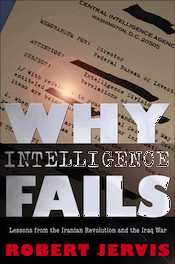 The final book in this feature exposes the reader to fascinating chapter in the history of U.S.-Iranian relations. Prior to the Iranian revolution of 1979 the U.S. and Iran were close allies, sharing a high-level intelligence and military relationship. Robert Jervis’s Why Intelligence Fails outlines a case study of the well-documented failure of the U.S government, and the CIA in particular, to anticipate fully the emerging revolutionary undercurrent in Iran in the mid-late 1970s. As a consultant to the CIA during the aforementioned period, Jervis applies his unique insight which he combines with a carefully arranged set of declassified primary source archival extracts to reconstruct the spiral of events within Iran.
The final book in this feature exposes the reader to fascinating chapter in the history of U.S.-Iranian relations. Prior to the Iranian revolution of 1979 the U.S. and Iran were close allies, sharing a high-level intelligence and military relationship. Robert Jervis’s Why Intelligence Fails outlines a case study of the well-documented failure of the U.S government, and the CIA in particular, to anticipate fully the emerging revolutionary undercurrent in Iran in the mid-late 1970s. As a consultant to the CIA during the aforementioned period, Jervis applies his unique insight which he combines with a carefully arranged set of declassified primary source archival extracts to reconstruct the spiral of events within Iran.
For students who do not have the opportunity to visit and use archival resources, this book is an excellent insight into the inner workings of the U.S. government. The book also features a second case study analysing the Iraq war of 2003 and the intelligence failures evident there due to the elusive weapons of mass destruction that were never found. In that sense, the book is a fascinating post-mortem on the consistent failures of intelligence and the lessons that can be learned from seemingly oft-repeated mistakes. The book is not quite a memoir, nor a straightforward historical reading, nor an explicit theoretical analysis – yet Jervis manages to harness elements of all three and form a truly worthwhile package.